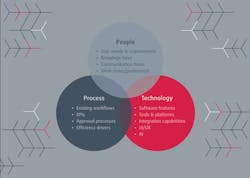Digitizing key processes such as shift handover and plant processes delivers clear benefits in plant safety, productivity and operational performance. And yet, nearly one-fourth of process manufacturers still rely on paper-based processes and systems for these key activities. An even larger number depend on an ad hoc mix of email, in-person communication and informal document sharing.
For companies who do invest in digitalization initiatives, research by McKinsey, Deloitte and others show that a majority fail to achieve long-term, sustainable change.
Successful digitalization lies at the intersection of technology, people and processes. Before rolling out new software, it is critical to first understand the needs of users and how the system will fit within or replace existing workflows.
As Gene Shields, chief information officer at Ascensus (a manufacturer of specialty reagents), noted, “You need to understand the problem you are trying to solve as well as the people that are impacted. It’s important to involve these people in the selection process. By doing so, you have a much higher probability of acceptance and ownership of the solution.”
Ascensus implemented Shiftconnector, shift handover software from Eschbach, in 2020. Their goals were to enhance communication, data transparency and safety across shifts. To ensure the success of the initiative, they used a planned, strategic rollout approach, starting with virtual workshops to gather user feedback and suggestions from a broad cross-section of the organization. The company then used these data points to tailor the software to the needs of their team. After the rollout, they continued to gather feedback and make iterative changes in response to user needs. This agile approach led to widespread acceptance among employees and highly effective use of the software to meet their goals.
This approach, as exemplified in Ascensus’s implementation of Shiftconnector, can be seen as part of Industry 5.0. While industry 4.0 centered on technology—especially automation driven by the Industrial Internet of Things (IIoT)—Industry 5.0 is about leveraging technology to enhance human capabilities and productivity.
A people-centered approach to digitalization will improve user acceptance and increase the odds that the initiative will deliver the expected performance improvements. The process starts before software selection and continues through and beyond the rollout.
Following is an explanation of the three key phases of a people-centered approach to new technology deployment.
Phase 1: Before the rollout
The foundation for a successful digitalization initiative is laid long before new software tools are introduced to users. Manufacturers must start by understanding existing processes and user requirements and laying out clear goals and objectives for the implementation. There are several important steps for this stage:
- Needs analysis: Begin by engaging with those directly impacted by the change to understand their daily workflows, priorities and concerns. This involves discussions with stakeholders across the organization, from shift workers to upper management, to identify potential barriers and gather feedback that can be used to customize the initiative to the specific needs of the organization or location.
- Goals and objectives: Before implementation, clearly define the project’s goals and the expected benefits for each stakeholder group. It is important to set specific and measurable key performance indicators (KPIs) for the initiative.
- Pilot testing: It is helpful to start with a small-scale pilot implementation, perhaps for a single plant. User feedback gathered in this stage can be used to make adjustments to software configuration and refine the rollout plan, which will help to ensure a smoother transition to full implementation.
- Planning and change management: Utilize insights from the pilot to create a detailed rollout plan grounded in best practices for change management. This includes identifying training needs and laying out a communication strategy for the rollout.
Phase 2: During the rollout
User acceptance and the overall success of the initiative depend on the support users receive during the rollout. It can often be helpful to identify change champions in each shift and department who can act as mentors and ease the transition.
- Training and support: Tailor training to employee roles, emphasizing interactive sessions and real-life scenarios. Employing a “train the trainer” approach, with trainers from each shift and department, is often very effective.
- Communication: Two-way communication is crucial during this phase. Keep employees informed of progress and gather user feedback, being prepared to address any point of resistance along the way. And don’t forget to celebrate successes, too.
- Monitoring and adjustment: Be prepared to modify plans based on feedback and outcomes. Address any training or IT issues promptly.
Phase 3: After the rollout
Effective change management extends beyond the initial rollout to provide ongoing support for users and iteration based on user feedback. Effectively managing the post-rollout phase can make the difference between a short-lived, but ultimately ineffective, program and long-term, sustainable change with measurable results.
- Ongoing support: Maintain IT and software support post-rollout to handle any issues and provide additional training as needed. Ensure regular communication to help employees integrate the new software into their daily routines.
- Documentation and feedback: Keep collecting feedback on software use and challenges. Monitor user engagement and the impact on workflows and processes. Acknowledge and incentivize teams or individuals who effectively use the new software.
- Evaluation and iteration: Reassess initial goals and KPIs to measure success. Investigate any discrepancies in expected outcomes, considering software usage and effectiveness. Use these findings to refine strategies for future digital initiatives.
The essence of successful digitalization lies not just in adopting new technologies but in prioritizing the people who use them. By engaging users from the outset and continuing support beyond implementation, companies can bridge the gap between digital potential and practical reality. This journey from pre-rollout planning through to sustained post-rollout support underscores the critical role of understanding, involving and adapting to the needs of those at the heart of digital transformation efforts.
About the Author

Leaders relevant to this article:


